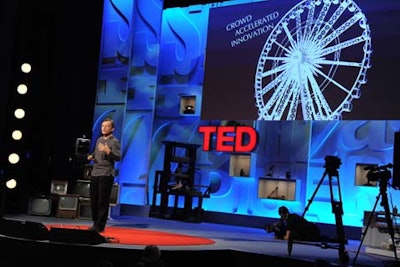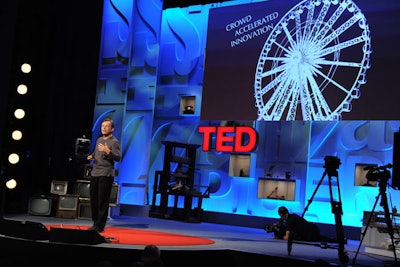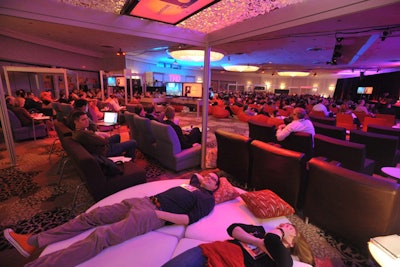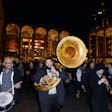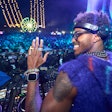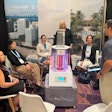It’s no secret that the Technology, Entertainment, and Design (TED) Conference has a strong following. The $6,000 tickets for the annual four-day gathering in Long Beach sell out a year in advance, and the speakers and attendees include politicians, entrepreneurs, activists, Nobel laureates, musicians, and Hollywood bigwigs. The brand has long been celebrated for its session style—where presenters speak about global issues, new technology, business, and scientific breakthroughs for no more than 18 minutes—and the engaging talks at its conference. In 2004, author Malcolm Gladwell famously related the invention of chunky spaghetti sauce to human nature at TED, and in 2009, Bill Gates made headlines for releasing mosquitoes whilst speaking about malaria.
But TED’s identity has become larger than its original conference, and the big-name guests and captivating presentations are only part of the package. TED’s other strengths lie in the innovative ideas publishing entrepreneur Chris Anderson has introduced since taking over the event from founder Richard Saul Wurman in 2001; he now operates it through his nonprofit the Sapling Foundation. Under Anderson’s curatorship, the gathering, previously accused of being elitist, has turned outward, incorporating brand extensions and open-source formats to involve a larger audience.
For one, TED started distributing its content for free, posting videos of speakers (dubbed TEDTalks) on its site, iTunes, and YouTube. The viral expansion in 2006 increased the scope of the conference in a big way; to date, there are more than 700 TEDTalks available, which have been viewed more than 350 million times. Moreover, a program allowing volunteers to translate the talks into non-English languages has boosted viewership since launching in 2009. In its first year, traffic from outside the U.S. grew by 350 percent.
“TED’s mission is to spread good thinking globally, and so it’s high time we began reaching out to the 4.5 billion people on the planet who don’t speak English,” Anderson said when the project was introduced. “We’re excited to be using a bottom-up, open-source approach that will in time allow all our talks to be translated into all the world’s languages.”
Making the talks accessible prompted a new branch of the brand, TEDx, a concept that enables anyone to host a TED-style gathering. This took the movement and popularity of the conference to a grassroots level.
“The TEDTalks really transformed the TED brand in that it moved it into this global sphere and was no longer just a conference. More and more people started coming to us, asking if they could hold an official TED conference,” said Lara Stein, the organization’s licensing director, who oversees TEDx. “So Chris and I started experimenting with what it would look like if we sort of gave away our brand in a very open-source way.” For the nonprofit’s small staff, allowing others to produce spin-offs using TED’s concept lets the brand leverage its platform without tripling the workload. “The idea of doing more than two, maybe three conferences a year is about as far as we can take it for us internally producing,” Stein says.
To pioneer the venture, TED partnered with the University of Southern California for TEDxUSC, held in March 2009 at a university auditorium. From the experience, Anderson and company were able to refine guidelines for TEDx events but still allow for local themes and speakers. Organizers of such gatherings require a free license and cannot promote any commercial, religious, or political agenda. Stein says the team is still refining rules concerning event programming, marketing, and sponsorship.
“A lot of what I do is listen to the community and try to figure out how to shape the guidelines based on what I hear. It has to be built with a great deal of flexibility, because it’s a global program and what works in the slums of Kibera [in Nairobi] doesn’t necessarily work in a 600-person venue in Amsterdam or Paris,” she says.
A recent addition to the model is TEDxLive, where TEDx events can stream Webcasts. This was available during TEDWomen, the two-day, female-focused convention held in Washington in December, and TED2011, the flagship conference in Long Beach.
This is not the organization’s first foray into simulcasting. TED-Active, which grew out of a satellite event in Aspen in 2008 and now takes place yearly in Palm Springs, offers a hybrid format, with live broadcasts of the sessions in Long Beach, as well as on-site activities. More informal than the main conference, TEDActive allows attendees to shape the content, suggesting ideas, hosting discussions, and participating in group workshops.
“Each year we’ve taken the participation component and really turned up the volume on it. We always try to provide a platform for attendees to organize things,” explained TEDActive director Kelly Stoetzel, who is also content director at TED. “This year we’re sponsoring a new initiative that takes things a step further, which is the ‘Projects’ initiative. We have six different themed projects, and attendees can sign on to do one of them.” The idea is for attendees to take a theme—such as education, travel, or sustainability—identify a challenge around the topic, and brainstorm active steps that can be taken to meet the challenge.
“At TED we’ve become a little obsessed with this idea of openness,” Anderson said during his presentation at TEDGlobal 2010. “We opened up our talks to the world, and suddenly there are millions of people out there helping spread our speakers’ ideas, and thereby making it easier for us to recruit and motivate the next generation of speakers.”
